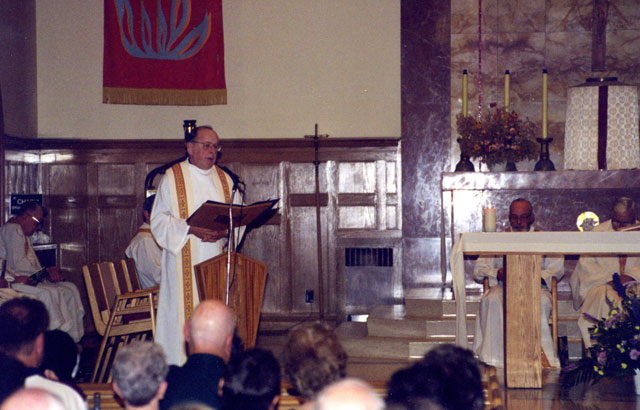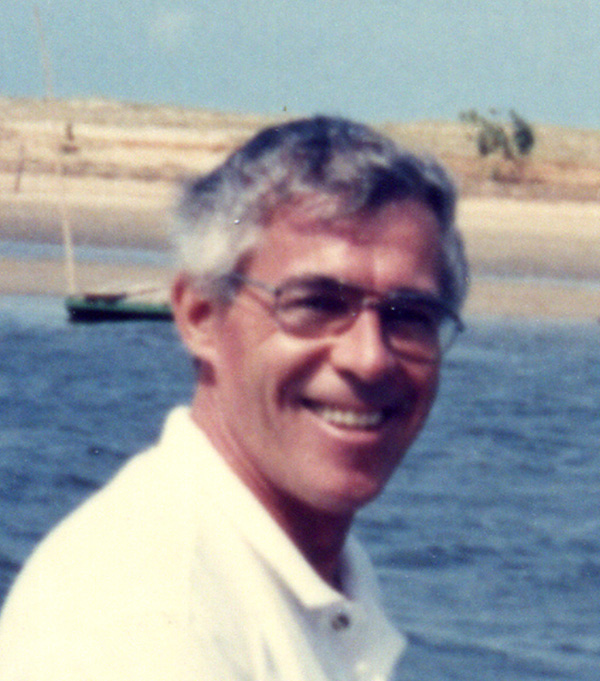A Grateful Man
Homily presented at the Memorial Mass for Bishop George Marskell, S.F.M.,
Saturday, July 4, 1998, at Scarboro Missions’ chapel, Scarborough, Ontario.
By Fr. John Walsh, S.F.M.
January 1999
Return to Table of Contents
Print Article
Cardinal Ambrozic, Bishop Tonnos, Bishop Knight, Bishop McHugh, Marie and Elizabeth*, members of the Society, friends:
How exquisitely Luke (Chapter 24:1-8) paints the scene at the empty tomb! How lovingly he details the time, the place, the people! The first day of the week; the first sign of dawn; the stone rolled away; the spices prepared; the messengers in bright clothes; the terrified women, not knowing what to think. How reassuring the message: “Remember what he told you...”
How the question echoes through the centuries! “Why look among the dead for someone who is alive?" The angels chide the women for seeking the living among the dead. It is advice for us.
We have come together this Saturday morning to pray and grieve for our friend, Bishop George Marskell; to remember and to give thanks for his life; to look at his place, time and people, and his discovery of the Risen Christ.
Bishop George was what used to be called a “cradle Catholic.” He was nurtured in the faith by his parents and the Catholic community of Hamilton. As a seminarian, I recall him being very proud of that heritage. He spoke lovingly of Cathedral High, St. Pat’s, and Fr. Mattice, but also of the steel city itself, Hamilton mountain, and the Tiger Cats. He had an affectionate local loyalty. So, today we also remember his father, Albert, his mother, Catherine Molloy, his brother, Jim.
Bishop George was a grateful man. In 1984 he wrote a note, in his distinctive handwriting, saying:
“I am grateful for the family I was born into, for Scarboro (Missions) and for my vocations—Christian, priesthood and episcopacy... I hope...that I have learned a little how to love, for that is our greatest vocation.”
For cradle Catholics, Catholicism and the Church were like oxygen. We breathed it in our very being. It pervaded our life. It is worthwhile, I think, on this occasion to examine a bit this Catholic tradition; how we, as Catholics, experience salvation in the Lord.
There is a very moving prayer in the funeral liturgy which reads: “Dear friends, may every mark of affection and every gesture of friendship that you give to others be a sign of God's peace for you.”
Doesn't the prayer recall to mind an affectionate, friendly Bishop George?
It, in a way, sums up the Catholic tradition’s embrace of the Incarnation, of all that is human: “Every mark of affection, every gesture of friendship…a sign of God's peace for you.” It reveals a sacramental view of creation: “Reality imbued with the hidden presence of God” (Paul VI).
This sacramental view sees the Divine in the human; the spiritual in the material; and the eternal in the historical. All reality is seen as holy. The history of the world is the history of salvation. (Richard McBrien, Catholicism, pp. 9 and 10.)
 (CREDIT: Fr. Gerald Curry, S.F.M.)
(CREDIT: Fr. Gerald Curry, S.F.M.)Fr. Walsh giving the homily at Bishop Marskell’s Memorial Mass, held at Scarboro Missions on July 4.
Bishop George grasped that sacramental vision and he lived his life and ministry, as a priest and bishop, by it. The sacramental view of life is not all seriousness; it is enjoyment of life, it’s the ability not to take ourselves too seriously, to be able to laugh at ourselves. We always enjoyed Bishop George’s company and his sense of humour.
Visitors to Third World countries often come away surprised by the hope and joy they find there in the people, despite the grinding poverty and misery. This hope and joy seems to be missing in the affluent world. Sometimes it is even missing among Christians, even among us priests.
Brazil and the Amazon, it seems, strengthened Bishop George’s sacramental vision. Here was a vast country with basically a Catholic ethos. There, day by day, he would literally rub elbows with caboclos, poor country folk, who unquestionably held a sacramental view of creation, an awareness of the closeness of God.
Bishop George often made points by telling stories from his experience; sometimes throwing Portuguese words into the conversation—words that better expressed his feelings and understanding. It was an indication of how closely he belonged to Brazilian culture.
These stories often illustrated, in practical ways, the Divine in the human: the affirmation of the poor, the uneducated, the powerless—seeing the face of Christ in the dispossessed.
His stories about the rain forest and peasant farmers, the ecology and the environment, reflected awareness of the spiritual in the material—the presence of the Creator God revealed in creation.
Ordained a bishop, he joined an outstanding College of Bishops which gave leadership to the people, for decades, in a troubled country. For these bishops, history evolving in Brazil was part of salvation history. God was not to be relegated to the past or reserved for the future alone. God is in the present.
Basic Christian Communities, the Assembly of the People, the Pastoral of the Land, are mostly interesting theoretical concepts for us. For Bishop George they were dynamic pastoral structures to involve the people in developing programs to meet their own needs in society and the Church; to be responsible to one another; to care for one another; to live out their baptismal commitment. As a bishop, he pursued the vision to promote a sacramental view of creation:
- To see the Divine
in the human - To see the spiritual
in the material - To see the eternal
in the historical - To see that all reality
is holy!
When he was here in Canada for treatment early this year, he spent a great deal of time almost in spiritual retreat. One of the books he found most helpful in dealing with his own illness and feelings was Cardinal Bernardin's The Gift of Peace.
The final words of the book read like this: “Today, while there is still breath in me, I offer you myself in faith, hope and love as well as in suffering, dying and peace.” (Cardinal Bernardin, The Gift of Peace, p. 147.)
I am sure Bishop George made those words his own—for us!
“I offer you myself...”
Friends, “Why look among the dead for someone who is alive?”
Return to Table of Contents
Print Article
